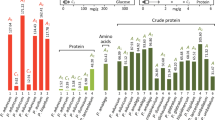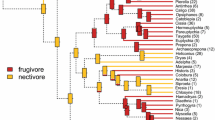Abstract
Fleshy-fruited plants and frugivores share a mutualistic relationship with plants offering the frugivores a reward of fleshy fruit pulp in order to disperse their seeds. However, all fruits are not equal in terms of energy available to frugivores. Consequently, we measured the assimilation efficiencies of fruits of six indigenous tree species for an avian frugivore, the Knysna Turaco (Tauraco corythaix). We predicted that the Turacos would process these indigenous fruits efficiently and have fast transit rates and high intake rates irrespective of species. Fruits were fed to the Turacos in separate trials to determine daily food and energy intake, assimilation efficiencies and digestive transit times. Digestive transit times of Knysna Turacos (c. 12–28 min) fall within the range of published examples for other frugivorous birds. Apparent assimilation efficiencies of the fruit ranged from c. 15–84% and were generally lower than those observed for other avian frugivores. Intake rates (in terms of wet weight) varied among the fruit species, and Knysna Turacos had greater intake rates on fruit which they are able to assimilate efficiently. Future studies looking at the nutritional composition of indigenous forest fruit may provide insight into the Knysna Turacos assimilation efficiency and consequently their food preferences and role as potential seed dispersers of fruiting tree species.
Zusammenfassung
Nahrungsaufnahmeraten, Verdauungseffizienz und Transitzeiten von Helmturakos ( Tauraco corythaix ), die mit einheimischen südafrikanischen Früchten gefüttert wurden
Pflanzen mit fleischigen Früchten und Fruchtfresser stehen in mutualistischer Beziehung—die Pflanzen bieten den Fruchtfressern eine Belohnung in Form von Fruchtfleisch, und diese verbreiten ihre Samen. Allerdings sind nicht alle Früchte gleichwertig im Hinblick auf die Energie, die für die Fruchtfresser nutzbar ist. Wir haben daher die Assimilationseffizienz von Früchten von sechs einheimischen Baumarten für einen fruchtfressenden Vogel, den Helmturako (Tauraco corythaix), gemessen. Wir haben vorhergesagt, dass die Turakos diese einheimischen Früchte effizient verarbeiten und schnelle Transitzeiten und hohe Aufnahmeraten haben, unabhängig von der Fruchtart. Die Früchte wurden den Turakos in separaten Versuchen gefüttert, um die tägliche Nahrungs- und Energieaufnahme, die Assimilationseffizienz und die Passagezeiten durch den Verdauungstrakt zu ermitteln. Die Transitzeiten der Helmturakos (ca. 12–28 min) fallen in den Bereich publizierter Beispiele für andere fruchtfressende Vögel. Die offensichtlichen Assimilationseffizienzen für die Früchte reichten von ca. 15–84% und waren allgemein niedriger als die für andere fruchtfressende Vögel beobachteten Werte. Aufnahmeraten (im Hinblick auf Feuchtmasse) variierten zwischen den Fruchtarten und waren höher für diejenigen Früchte, welche die Helmturakos effizienter verdauen können. Zukünftige Studien, welche die Nährstoffzusammensetzung einheimischer Waldfrüchte untersuchen, könnten Einblicke in die Assimilationseffizienz der Helmturakos und folglich in ihre Nahrungspräferenzen und ihre Rolle als potenzielle Samenverbreiter fruchtender Baumarten gewähren.
Similar content being viewed by others
References
Afik D, Karasov WH (1995) The trade-offs between digestion rate and efficiency in warblers and their ecological implications. Ecology 76:2247–2257
Avery ML, Schreiber CL, Decker DG (1999) Fruit sugar preferences of house finches. Wilson Bull 111:84–88
Ayala-Berdon J, Schondube JE, Stoner KE, Rodriguez-Peña N, Martínez del Rio C (2008) The intake responses of three species of leaf-nosed Neotropical bats. J Comp Physiol 178B:477–485
Bairlein F (1999) Energy and nutrient utilisation efficiencies in birds—A review. In: Adams NJ, Slotow RH (eds) Proceedings of 22nd international ornithology congress, Durban: 2221–2246. BirdLife South Africa, Johannesburg
Boon R (2010) Pooley’s trees of Eastern South Africa. A complete guide. Flora & Fauna, Durban
Brown KJ, Downs CT (2003) Digestive efficiency of a generalist avian feeder, the Cape White-eye (Zosterops pallidus). Comp Biochem Physiol 134A:739–748
Castro G, Stoyan S, Myers JP (1989) Assimilation efficiency in birds: a function of taxon or food type? Comp Biochem Physiol 92A:271–278
Downs CT (2008) Aspects of diet choice and digestion in the dark-capped bulbul Pycnonotus barbatus. Ostrich 79:73–78
Du Plessis MA, Dean WRJ (2005) Knysna turaco, Tauraco corythaix. In: Hockey PAR, Dean WRJ, Ryan PG (eds) Roberts birds of Southern Africa, 7th edn. The trustees of the John voelcker bird book fund, Cape Town, pp 246–247
Fuentes M (1994) Diets of fruit-eating birds: what are the causes of interspecific differences? Oecologia 97:134–142
Griffiths ME, Lawes MJ (2006) Biogeographic, environmental, and phylogenetic influences on reproductive traits in subtropical forest trees, South Africa. Ecography 29:614–622
Herrera CM (1981) Are tropical fruits more rewarding than temperate ones? Am Nat 118:896–907
Howe HF, Vande Kerckhove GA (1981) Removal of wild nutmeg (Virola surinamensis) crops by birds. Ecology 62:1093–1106
Izhaki I (1993) Influence of nonprotein nitrogen in fleshy fruits. J Chem Ecol 19:2605–2615
Jordano P (1995) Frugivore-mediated selection on fruit and seed size: birds and St. Lucie’s cherry, Prunus mahaleb. Ecology 76:2627–2639
Karasov WH (1990) Digestion in birds: chemical and physiological determinants and ecological implications. Stud Avian Biol 13:391–415
Karasov WH, Levey DJ (1990) Digestive system trade-offs and adaptations of frugivorous passerine birds. Physiol Zool 63:1248–1270
Klasing KC (1998) Comparative avian nutrition. CAB International, New York
Lepczyk CA, Murray KG, Winnett-Murray K, Bartell P, Geyer E, Work T (2000) Seasonal fruit preferences for lipids and sugars by American robins. Auk 117:709–717
Levey DJ, Karasov WH (1989) Digestive responses of temperate birds switched to fruit or insect diets. Auk 106:675–686
Levey DJ, Karasov WH (1994) Gut passage of insects by European starlings and comparison with other species. Auk 111:478–481
Levey DJ, Martínez del Rio C (1999) Test, rejection, and reformulation of a chemical reactor-based model of gut function in a fruit-eating bird. Physiol Biochem Zool 72:369–383
Levey DJ, Martínez del Rio C (2001) It takes guts (and more) to eat fruit: lessons from avian nutritional ecology. Auk 118:819–831
Linnebjerg JF, Hansen DM, Olesen JM (2009) Gut passage effect of the introduced red-whiskered bulbul (Pycnonotus jocosus) on germination of invasive plant species in Mauritius. Austral Ecol 34:272–277
Martínez del Rio C (1990) Dietary, phylogenetic, and ecological correlates of intestinal sucrase and maltase activity in birds. Physiol Zool 63:987–1011
Martínez del Rio C, Restrepo C (1993) Ecological and behavioral consequences of digestion in frugivorous animals. Vegetatio 107(108):205–216
Martínez del Rio C, Karasov WH, Levey DH (1989) Physiological basis and ecological consequences of sugar preferences in cedar waxwings. Auk 106:64–71
Murphy SR, Reid N, Yan ZG, Venables WN (1993) Differential passage time of mistletoe fruits through the gut of honeyeaters and flowerpeckers. Effect on seedling establishment. Oecologia 93:171–176
Oatley TB (1997) Knysna Lourie. In: Harrison JA, Allan DG, Underhill LG, Herremans M, Tree AJ, Parker V, Brown CJ (eds) The Atlas of Southern African Birds. Vol 1: Non-passerines. Birdlife South Africa, Johannesburg, pp 538–539
Rowan MK (1983) The doves, parrots, louries and cuckoos of Southern Africa. David Philip, Cape Town
Schoener TW (1971) Theory of feeding strategies. Annu Rev Ecol Syst 2:369–404
Schuler W (1983) Responses to sugars and their behavioural mechanisms in the starling (Sturnus vulgaris L.). Behav Ecol Sociobiol 13:243–251
Sibly RM (1981) Strategies of digestion and defecation. In: Townsend CR, Calow P (eds) Physiological ecology. Sinauer, Sutherland, pp 109–139
Slansky F, Wheeler GS (1992) Caterpillars compensatory feeding response to diluted nutrients leads to toxic allelochemical dose. Entomol Exp Appl 65:171–186
Van der Pijl L (1982) Principles of dispersal in higher plants. Springer, Berlin
Wellmann AE, Downs CT (2009) Sugar preferences and digestion by Cape white-eyes, Zosterops virens, fed artificial fruit diets. Afr Zool 44:106–116
Wilson A-L, Downs CT (2011a) Digestive efficiency of Knysna and Purple-crested Turacos fed varying concentrations of equicaloric and equimolar artificial fruit. J Exp Biol 214:607–612
Wilson A-L, Downs CT (2011b) Fruit nutritional composition and non-nutritive traits of indigenous South African tree species, S Afr J Bot. in press doi:10.1016/j.sajb.2011.04.008
Witmer MC (1998a) Ecological and evolutionary implications of energy and protein requirements of avian frugivores eating sugary diets. Physiol Zool 71:599–610
Witmer MC (1998b) Do seed hinder digestive processing of fruit pulp? Implications for plant/frugivore mutualisms. Auk 115:319–326
Witmer MC (1999) Do avian frugivores absorb fruit sugars inefficiently? How dietary concentration can affect coefficients of digestive efficiency. J Avian Biol 30:1–6
Worthington AH (1989) Adaptations for avian frugivory: assimilation efficiency and gut transit time of Manacus vitellinus and Pipra mentalis. Oecologia 80:381–389
Acknowledgments
A.-L. Wilson would like to thank the National Research Foundation for financial assistance. We thank the Pietermaritzburg SANBI Botanical Gardens and Isobel Johnson in particular for allowing and assisting us with fruit collection; Allison Young and the UKZN Botanical Gardens for allowing the use of their premises and for general assistance; Adam Shuttleworth for his valuable advice, proofreading and assistance with data collection; Mark Brown, the Animal House and Thami Mjwara for housing and caring for the Turacos; Rosemary Wilson, Lorinda Jordaan, James Harvey and Janet Taylor for assistance with data collection; Helen and Andy Shuttleworth for general assistance and land use; and Christina Potgieter, and Meyrick Bowker for general advice and assistance. Ethical clearance for this study has been approved by the Animal Ethics sub-committee of the University of KwaZulu-Natal.
Author information
Authors and Affiliations
Corresponding author
Additional information
Communicated by C. G. Guglielmo.
Rights and permissions
About this article
Cite this article
Wilson, AL., Downs, C.T. Food intake rates, assimilation efficiency, and transit times of Knysna (Tauraco corythaix) Turacos fed South African indigenous fruit. J Ornithol 153, 285–290 (2012). https://doi.org/10.1007/s10336-011-0741-y
Received:
Revised:
Accepted:
Published:
Issue Date:
DOI: https://doi.org/10.1007/s10336-011-0741-y




